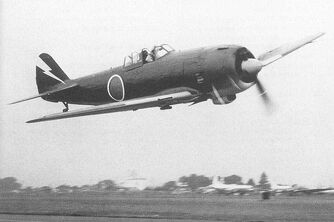
A Ki-84 Frank.
The Nakajima Ki-84 Hayate, Allied codename "Frank", was Japan's best fighter aircraft of World War 2. It could outturn and outrun the P-51 Mustang. Unlike the A6M Zero; the Frank had armour; self-sealing fuel tanks, and better armament. Only one Frank survives today.
Design and development[]
Design of the Ki-84 commenced in early 1942 to meet an Imperial Japanese Army Air Service requirement for a replacement to Nakajima's own, earlier Ki-43 fighter, then just entering service. The specification recognized the need to combine the maneuverability of the Ki-43 with performance to match the best western fighters, and heavy firepower.[5] The Ki-84 first flew in March 1943 [6] and deliveries from Nakajima's Ota factory commenced in April 1943.[7] Although the design was itself solid, growing difficulties in securing skilled pilots, proper fuel and construction materials, and adequate manufacture often prevented the aircraft from reaching its full potential in the field.
The design of the Ki-84 addressed the most common complaints about the popular and highly maneuverable Ki-43: insufficient firepower, poor defensive armor, and lack of climbing speed. The Ki-84 was a cantilever low-wing monoplane of all-metal construction, except for the fabric-covered control surfaces. It had retractable tailwheel landing gear.[8] Armament comprised two fuselage-mounted, synchronized 12.7 mm (.50 in) machine guns — these proved challenging to synchronize properly with the Hayate's four-blade propeller — and two wing-mounted 20 mm cannon, a considerable improvement over the two 12.7 mm (.50 in) machine guns used in the Ki-43 Hayabusa. Defensive armor offered Hayate pilots better protection than the unsealed wing tanks and light-alloy airframe of the Ki-43. In addition, the Ki-84 used a 65 mm (2.56 in) armor-glass canopy, 13 mm (.51 in) of head and back armor, and multiple bulkheads in the fuselage, which protected both the methanol-water tank (used to increase the effectiveness of the supercharger) and the centrally located fuel tank.
It was the Nakajima firm's own-designed 35.8 litre displacement, Ha-45 Homare ("Praise or Honor") air-cooled eighteen-cylinder radial engine, first accepted for military use in 1941, that gave the Hayate its high speed and prowess in combat. Derived from the Nakajima Homare engines common to many Japanese aircraft, the Hayate used the Homare 21 direct-injection version of the engine, using water injection to aid the supercharger in giving the Ki-84 a rated 1,491 kW (2,000 hp) at takeoff. This combination theoretically gave it a climb rate and top speed roughly competitive with the top Allied fighters. Initial Hayate testing at Tachikawa in early summer 1943 saw test pilot Lieutenant Funabashi reach a maximum level airspeed of 624 km/h (387 mph) in the second prototype. After the war a captured late-production example was tested in the US and achieved a speed of 680 km/h (422 mph)[9] using 92 octane AvGas, plus methanol injection.[10]
The complicated direct-injection engine was a compact design (only 3 cm/1¼ inches larger in diameter than the Ki-43's 27.9 L 14-cylinder Nakajima Sakae radial) that required a great deal of care in construction and maintenance and it became increasingly difficult to maintain the type's designed performance as the Allies advanced toward the Japanese homeland. To compound reliability problems, the Allied submarine blockade prevented delivery of crucial components, such as the landing gear. Many landing gear units were compromised by the poor-quality heat treatment of late-war Japanese steel. As a result, many Hayates suffered strut collapses on landing. Further damage was caused by inadequately trained late war pilots, who sometimes found it difficult to transition to the relatively "hot" Ki-84 from the comparatively docile Ki-43, which had a significantly lower landing speed.
History[]
The Hayate was concieved in the Spring of 1942, in response to a specification which demanded a third generation fighter combining a heavy armament with the manoeuvrability of the Ki 43 Hayabusa and the speed of the Ki 44 Shoki.[1]
Variants[]
References[]
- ↑ Green, William. Page 134
Bibliography[]
Green, William. Famous Fighters of the Second World War. Book Club Associates. 1979.